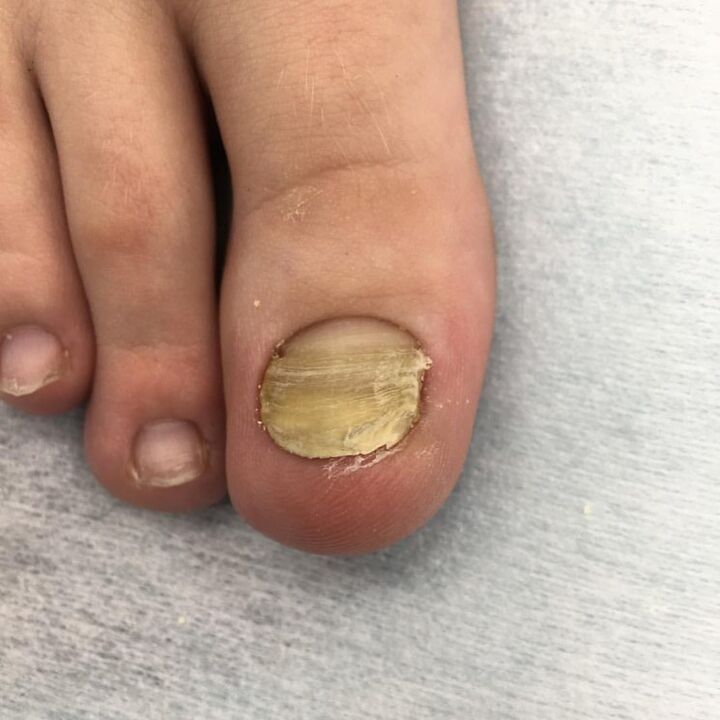Onicycosis: damage to nails with fungal infection. The disease occurs in 5-10% of the population and, among other nail injuries, is approximately 30%.
The causes of onychomycosis
The infection of feet nail plates occurs mainly in public bathrooms, saunas, swimming pools. Scales with pathogenic fungi, which fall in patients with onychomycosis, fall into floors, banks, bars, roads, carpets and garbage. Under high humidity conditions, fungi can not only persist for a long time, but also multiply, especially in unpainted wooden banks and grids, which makes them an intense source of infection.

Often, onychomycosis is transmitted inside the family when using general shoes, towels, towels, insufficient bathroom processing after washing, as well as due to carpets and grilles in the bathroom. The damage to the nails of the hands generally occurs when combing the spotlights on the skin.
The appearance of onychomycosis is facilitated by the trauma of the nails, especially multiple (in athletes), blood supply altered to the extremities, serious concomitant diseases (diabetes mellitus, states of immune, blood disease).
Onicycosis is often found in people who have received antibacterial, corticosteroid and immunosuptive therapy. The injury of nail plates occurs secondly: at the beginning, fungi affect interdigital folds or sole, and then nails.
Three types of onylomycosis are distinguished worldwide:
- Normotorófico,
- hypertrophic
- Atrophic
With a soft type of onychomycosis, only changes the color of the nails: in its extreme departments, spots and stripes appear, whose color varies from white to guard. Little by little, the entire nail changes the color, maintaining, however, shines and the normal thickness.
With a hypertrophic guy, the color changes, the nail loses the brightness, becomes opaque, thick and partially deformed, especially from the sides. Often, patients experience pain when walking. A typical fungus of the nail is characterized by a boring brown color coloration of the affected part of the nail, its thinning and rejection of the box; The naked area is covered with loose layers.
We treat the fungus
Local antimicotic agents are ineffective with damage to nail plates. Processing with antifungal ointments, creams, solutions, varnishes should be preceded by eliminating the affected area of the nail mechanically or using keratolytic tasks.
Mechanical elimination consists of cutting or cutting with bites of affected fragments of the nail plate.
The use of keratolithic plasters in the treatment of onychomycosis allows you to soften the nail, as a result of which easily eliminates and without pain from the surface of the nail bed with a scalpel or opaque scissors.
As a keratolithic agent, a drug is used, which includes an ointment containing 1% antimicotic agent and 40% urea. The ointment applies to the nail surface and covered with the adhesive and the united bandage. After one day, the areas affected by onychomycosis are cleaned. The procedures are performed daily until affected nails are completely eliminated. In the future, as the affected nail is eliminated, premises are used: antimicotic varnishes.
- In the first month of treatment, a medication for 6-8 tablets per day (750-1000 mg) is prescribed, in the second in the same dose every two days, and then, to the growth of healthy nail plates, 2 times a week. It is taken in 3 doses with a teaspoon of vegetable oil. The duration of treatment for brushes mycosis is 4 to 6 months, with a feet mycosis-9-12 and even 18 months.
- The treatment with the preparation against the fungus ensures a cure only in 40% of the patients. A combination with nail elimination increases the percentage of cure. However, a large amount of side effects, as well as a high percentage of relapse of the disease, limit its use.

For successful and safe treatment of onychomycosis, it is advisable to adhere to certain rules with systemic antimicotic medications.
First, the diagnosis must be reliable. The medicine should not be prescribed if there is no laboratory confirmation.
After diagnosing, it is necessary to carefully collect an allergic history. If at the same time, drugs or foods that cause allergic reactions or any other manifestation of intolerance are detected, then its intake must be excluded.
For the treatment period with systemic antimicots, it is advisable to limit the use of other medications, with the exception of vital.
Prevention and treatment
To prevent gastrointestinal disorders, it is recommended to exclude products that cause food flatulence during treatment: black bread, legumes, milk, cabbage.
Not important is not the selection of comfortable shoes both during treatment and after its completion. Often, an improvement in the condition of the affected nail is clearly correlated with the use of non -traumatic shoes, since the pollination of the tissues caused by the shoes can cause exacerbation or distal to the nail of the nail. Before starting the treatment, it is advisable to carry out a study of general and biochemical blood analysis indicators.
Control exams must be carried out the first time after 2 weeks, then 1 time per month. Control microscopy: 6 months after the end of treatment. The identification of the mycelium of pathogenic fungi serves as an indication for a second treatment course with preliminary surgical elimination of the affected nails.
Prognosis for the treatment of onychomycosis
Despite the high percentage of cure for patients with onylomycosis when therapeutic agents are used, therapy with these medications does not exclude the use of local antimicotic medications. The combination with the conservative and surgical elimination of the nail plates reduces the time to take anti -systemic bactericidal agents and increases the effectiveness of the treatment.























